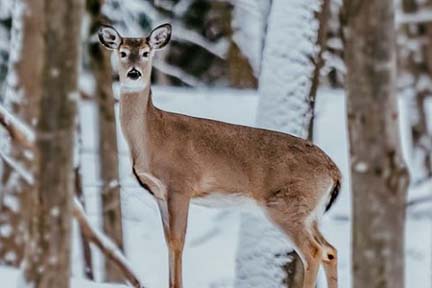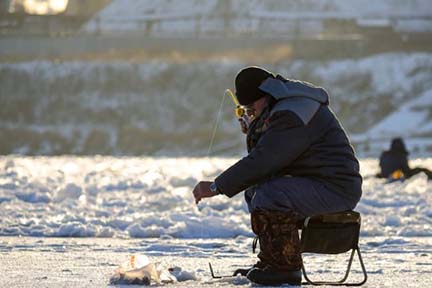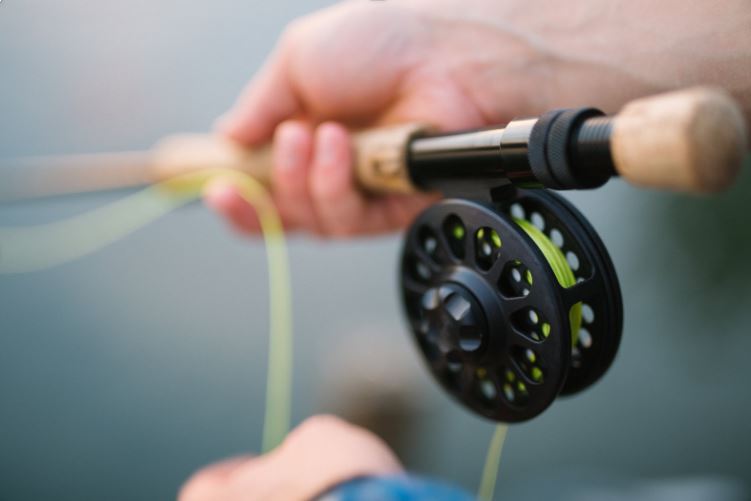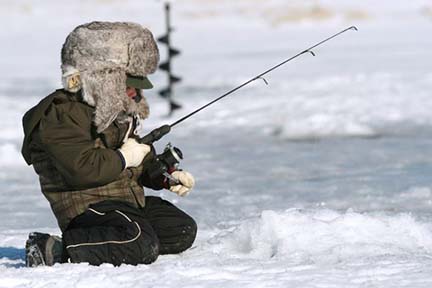| Here are a few of this week’s stories from the Michigan Department of Natural Resources:
See other news releases, Showcasing the DNR stories, photos and other resources at Michigan.gov/DNRPressRoom.
Larger, higher-res versions of some of the images used in this email (snowmobiling, lantern-lit cross-country skiing, Hard Water School and elk) are available in the DNR’s online photo gallery.
 Some things just go together: peanut butter and jelly, salt and pepper … social media and the great outdoors? Okay, that last pair may not be an obvious link, but at the DNR we use our social platforms to do just that – help more people discover and enjoy Michigan’s natural world and outdoor recreation opportunities. Some things just go together: peanut butter and jelly, salt and pepper … social media and the great outdoors? Okay, that last pair may not be an obvious link, but at the DNR we use our social platforms to do just that – help more people discover and enjoy Michigan’s natural world and outdoor recreation opportunities.
According to DNR social media specialist Tyler Czarnopis, it’s about meeting new and existing customers where they are.
“We love listening to how people enjoy the outdoors and talking with them about something we all have in common, our passion and appreciation for Michigan’s natural spaces,” he said. “Then there are the newbies, those folks who are curious about the outdoors but maybe are a little intimidated because they haven’t had the chance to get out there yet.
“We are focused on delivering meaningful, informative content that helps people of all experience and comfort levels.”
Czarnopis said you never know which posts are going to spark conversation. Recent efforts with big engagement include this little video of a fish ladder prompting some international intrigue and a fun, educational discussion on fisheries management in Michigan; the popular IdentiFriday identification game (here’s a quick year-in-review post) about the state’s native and invasive species; and a tongue-in-cheek post sharing a permission slip for hunters during firearm deer season. |
Those are a few examples of what you can learn and talk about on DNR social. If you have questions, we have answers! The growth in this arena shows no signs of slowing either; the DNR Instagram account broke 100,000 followers in 2024, Facebook is up over 270,000 followers, and we continue to expand on other platforms. That includes stepping into the new Bluesky, too.
If you’re on social, check us out at:
There are additional DNR social channels to explore, too, for individual state parks, trails and waterways, fisheries and wildlife. Need more info? Contact Tyler Czarnopis at CzarnopisT@Michigan.gov.
 The DNR Wildlife Division’s “Wildtalk” podcast is hitting January in full stride. Show hosts talk to Olivia Triltsch, Michigan United Conservation Clubs’ Habitat Program and Partnerships coordinator, about MUCC’s On the Ground program, get into a high-flying discussion about snow geese, and wrap with a chat about coyotes and why you’re likely to see and hear more of them this month. The DNR Wildlife Division’s “Wildtalk” podcast is hitting January in full stride. Show hosts talk to Olivia Triltsch, Michigan United Conservation Clubs’ Habitat Program and Partnerships coordinator, about MUCC’s On the Ground program, get into a high-flying discussion about snow geese, and wrap with a chat about coyotes and why you’re likely to see and hear more of them this month.
Now in its eighth year, “Wildtalk” remains focused on providing core components – insights, interviews and questions answered on the air – but show producers also say they’re looking at 2025 as a season of “scheming, plotting and looking ahead” to try out some new things!
Listener feedback is going to play a big part in the show’s progression. In fact, listeners are invited to take a survey that’s open right now. A bonus: Completing the survey gives you an extra chance to win one of the show’s popular camp mugs.
Want to hear more? Visit the “Wildtalk” webpage for the January episode, as well as show notes and links to past episodes. Questions about the podcast? Email DNR-Wildlife@Michigan.gov. |
If you want to start 2025 with some time in Michigan’s great outdoors, there are plenty of opportunities on tap this month. Here are a few ways to enjoy Michigan’s natural and cultural resources in January. For a full list of DNR events, see Michigan.gov/DNRCalendar.
Take in fresh air, scenic views
 Make the most of winter – whether it’s on snowshoes, cross-country skis or boots – during several events at state parks this month, including: Make the most of winter – whether it’s on snowshoes, cross-country skis or boots – during several events at state parks this month, including:
Find winter adventure on the dunes
Cyclists can enjoy 450 acres of open sand dunes, elevation changes of 80-100 feet, access to Lake Michigan and sunsets over the lake from the top of the dunes during the fat-tire biking season at Silver Lake State Park in Mears, continuing through March 15. There is no cost or registration, but you will need the Recreation Passport if you’re parking a vehicle.
Michigan also has some of the best fat-tire trails in the country – learn about other riding opportunities around the state on our fat-tire biking webpage. |
Learn to ice fish from the pros
 The DNR Outdoor Skills Academy offers a chance to learn how to ice fish with professional anglers during Hard Water School, Jan. 18-19 at the Carl T. Johnson Hunting and Fishing Center in Cadillac’s Mitchell State Park. This two-day class will cover everything you need to know to catch panfish, walleye and northern pike through the ice. The DNR Outdoor Skills Academy offers a chance to learn how to ice fish with professional anglers during Hard Water School, Jan. 18-19 at the Carl T. Johnson Hunting and Fishing Center in Cadillac’s Mitchell State Park. This two-day class will cover everything you need to know to catch panfish, walleye and northern pike through the ice.
Next month, look for a more in-depth Outdoor Skills Academy ice fishing class, Advanced Hard Water School, Feb. 15-16 at the Carl T. Johnson Center.
Recharge with a winter weekend up north
Enjoy a self-guided cross-country ski and snowshoe getaway weekend at the Ralph A. MacMullan Conference Center in Roscommon, Jan. 24-26 or Jan. 31-Feb. 2, perfect for individuals, couples or families seeking to enjoy the best parts of Michigan winter. Explore over 8 miles of evergreen-lined trails at the RAM Center or the old-growth forest at nearby Hartwick Pines State Park.
Or if you’re looking for a more guided experience in the same up-north setting, join staff from the RAM Center and the Outdoor Adventure Center for Winter Wonderland, Jan. 27-29. This two-night, three-day adventure includes special presentations on topics such as Michigan wildlife and trails, guided winter birding activities and an evening “owl prowl.”
Get some up north, downtown
If you’re in the Detroit area, check out the Outdoor Adventure Center activity schedule for a variety of fun and educational programs for all ages, from kids to seniors, both indoors and outdoors. The January calendar includes archery, birding, an “owl prowl,” yoga with a wildlife twist, state park trivia and much more. |
 Members of the Michigan Natural Resources Commission this week will take up an agenda that includes presentation of Lifesaving Awards from the DNR Law Enforcement Division and updates on several land transactions and elk season results. Members of the Michigan Natural Resources Commission this week will take up an agenda that includes presentation of Lifesaving Awards from the DNR Law Enforcement Division and updates on several land transactions and elk season results.
The meeting starts at 8:30 a.m. Thursday, Jan. 9, in the Michigan Room, first floor, 600 N. Grand Ave., on the downtown campus of Lansing Community College, in Lansing. (Public parking is available on first floor in the ramp.)
See the draft NRC meeting agenda and more commission information at Michigan.gov/NRC. Questions? Email NRC@Michigan.gov.
 See more pictures by Michigan state parks photo ambassadors at Instagram.com/MiStateParks. For more on the program, call Stephanie Yancer at 989-274-6182. (This photo is by Samantha Hageman Gaina, for the Michigan DNR, at Porcupine Mountains Wilderness State Park in the western Upper Peninsula.) See more pictures by Michigan state parks photo ambassadors at Instagram.com/MiStateParks. For more on the program, call Stephanie Yancer at 989-274-6182. (This photo is by Samantha Hageman Gaina, for the Michigan DNR, at Porcupine Mountains Wilderness State Park in the western Upper Peninsula.)
|











